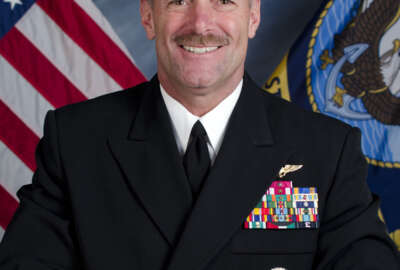
Navy is an orchestra in need of a score
The Navy is missing opportunities to turn connectedness into greater capability because its thinking is outdated.
The Navy is missing opportunities to turn connectedness into greater capability because its thinking is outdated.
“It’s an orchestra of capability that is conducted by the fleet commander … that takes from the capabilities of all of the different warfare communities — air, surface, subsurface, electronic warfare, cyber,” Bryan McGrath, managing director of The Ferrybridge Group LLC, a consulting group that specializes in defense and national security, said as part of Federal News Radio’s Navy Month. “The problem is though we fight that way, as a symphony, we don’t buy the Navy as a symphony. We don’t think across the instrumental lines.”
McGrath said the Navy buys ships, planes and submarines, and only then begins thinking about how to merge them together. Instead, he said the Navy should be thinking about its system and how each platform could interact.
“We need a score. We don’t have a score for this orchestra,” he told the Federal Drive with Tom Temin.
For example, the F-35 is the Navy’s newest fighter jet. On top of its other capabilities, it has a suite of sensors — reconnaissance, surveillance, and intelligence — that provide the jet with a more complete picture of a battlefield.
McGrath wondered what if that picture could be provided to a submarine? That information, in addition to informing the pilot of the fighter, could also provide tracks for other platforms to fire. Granted, that would be an engineering feat, he said, to get this jet in the air to transfer its information to a submarine deep underwater.
But these opportunities to connect should be what drives new Navy systems, McGrath said. They need to be identified, in order to provide a road map to the people responsible for the architecture.
“The bottom line is, it would be good to get that data to that submarine,” McGrath said. “We need to think more about how to merge those two pieces of the orchestra.”
He said the Navy staff at the Pentagon could begin doing this, as could the U.S. Fleet Forces Command in Norfolk, Virginia. But neither staff is organized nor resourced to do it well.
That’s because while the uniformed services are very aware of threats and the requirements to prepare for them, there’s a difference between what they’re resourcing and what they’re building now, McGrath said. That’s because political leadership doesn’t want to prepare in the same way that uniformed officers want to prepare.
“Congress generally gives the military what the military asks for,” McGrath said. “What has to happen is that the military has to ask for what it needs instead of self-editing. That’s going to take some courage from the uniforms to be more public about the difference between what they have and what they need in order to create some pressure on leadership. They can do it without stepping out of line, without being disrespectful or insubordinate, but they have to be relentless in making that case.”
Copyright © 2024 Federal News Network. All rights reserved. This website is not intended for users located within the European Economic Area.
Daisy Thornton is Federal News Network’s digital managing editor. In addition to her editing responsibilities, she covers federal management, workforce and technology issues. She is also the commentary editor; email her your letters to the editor and pitches for contributed bylines.
Follow @dthorntonWFED



